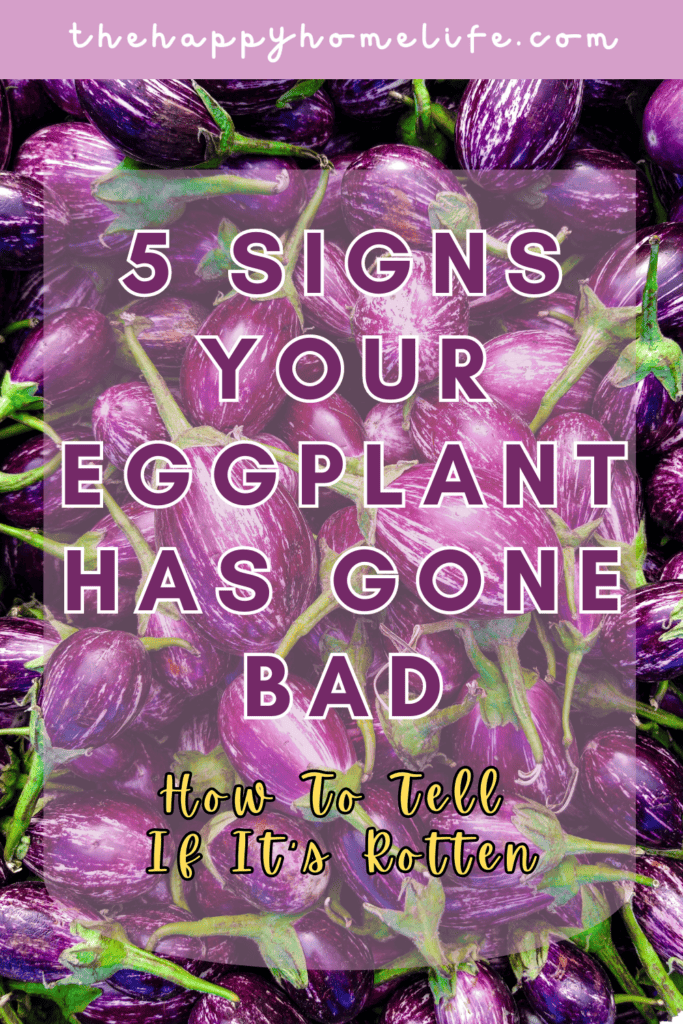Eggplants are a versatile and delicious vegetable that can be used in a variety of dishes. However, like any other food, they can go bad if not stored or handled properly. If you’re wondering how to tell if eggplant is bad, there are a few key signs to look out for.
Signs Your Eggplant Has Gone Bad
Look for several key indicators to determine if an eggplant has gone bad. Spoilage is evident if the eggplant’s vibrant purple skin turns brown or develops dark spots or if the skin appears shriveled. A fresh eggplant should be firm; a mushy texture or soft spots suggest decay. A healthy eggplant typically lacks a strong smell, so any sour or rotten odors indicate spoilage. Visible mold, especially around the stem, is a clear sign of rotting, and the interior flesh should be creamy white—brown streaks or extensive discoloration inside suggest the eggplant is past its prime. Monitoring these signs will help ensure you use eggplants when they are fresh and avoid consuming spoiled produce.
Let’s go over five indicators that your eggplant may have gone bad and what you can do to prevent it from happening. By learning these simple tips, you’ll be able to ensure that your eggplants are always fresh and safe to eat.

Jump right in, and learn how to tell if your eggplant has gone bad!
1) The Appearance of the Eggplant
When it comes to determining whether your eggplant has gone bad, the appearance is a crucial factor to consider. A fresh and healthy eggplant should have a smooth, shiny, and firm skin. The color of the skin should be deep and vibrant, usually ranging from dark purple to a rich, glossy black. Any discoloration, such as brown or yellow spots, can be a sign that the eggplant is past its prime.
Another visual indicator of a bad eggplant is a wrinkled or shriveled skin. This usually occurs when the vegetable has been sitting for too long, losing moisture and becoming dehydrated.
A slimy or mushy texture is also a clear indication of a spoiled eggplant.
Cutting into the eggplant can reveal further signs of spoilage. If the flesh is brown inside, rather than the usual creamy white or pale green, it is an indication that the eggplant is overripe and no longer suitable for consumption.
The seeds inside should also be small and pale, not dark or blackened.
To prevent your eggplants from going bad, store them in a cool, dry place, away from direct sunlight. If you notice any signs of a bad eggplant, it’s best to discard it to avoid any potential foodborne illnesses.
2) The Texture of the Eggplant
The texture of an eggplant can be a telling sign of whether it has gone bad. A fresh eggplant should have a firm and slightly spongy texture. When you gently press on the skin, it should give a little but quickly bounce back. However, if you find that the texture is mushy or slimy, it is a clear indication that the eggplant is no longer fresh.
Another texture indicator of a bad eggplant is a rubbery or tough consistency. This can happen when the eggplant has been stored for too long or has experienced temperature fluctuations. When you bite into a fresh eggplant, it should have a slightly creamy and tender texture. If you find that the flesh is dry and lacks moisture, it is likely past its prime.
You might enjoy these posts:
- Simple Tricks for Knowing When Your Mayo Is Spoiled
- How Long Can Cooked Salmon Sit Out? Signs of Spoilage
- Why Is My Soup Foamy?
Cutting into the eggplant can also reveal texture issues. If the flesh is brown inside instead of the usual creamy white or pale green, it is an indication that the eggplant is overripe and has started to decay. The seeds inside should be small and pale, not dark or blackened.
To keep your eggplants fresh, keep them in a cool and dry place, such as the refrigerator’s vegetable drawer, to maintain their texture and freshness.
3) The Smell of the Eggplant
Another key indicator is its smell. A fresh eggplant should have a mild, earthy scent. It may have a slight sweetness or nuttiness to it. However, if you detect any foul or pungent odors, this indicates that the eggplant is past its prime and has gone bad.
An overripe eggplant can emit a strong, unpleasant smell that is often described as sour or rotten. This smell occurs when the eggplant begins to decompose, releasing chemicals that create an offensive odor. It’s important to note that a slight bitterness in the smell is normal, as eggplants contain natural compounds that can contribute to this aroma.
When is an eggplant bad? If you find yourself holding an eggplant that has an overpowering or off-putting smell, it’s best to discard it. This is especially true if the smell is accompanied by other signs of spoilage, such as a mushy texture or discolored skin. Trust your nose and rely on its powerful ability to detect the slightest changes in the aroma of your eggplant.
4) The Color of the Eggplant
Take a look at the color when determining if your eggplant is good or bad. A fresh eggplant should have a vibrant and consistent color throughout its skin. The ideal color of a ripe eggplant is a deep purple or glossy black, indicating that it is at its peak of freshness and flavor.
However, if you notice any brown or discolored patches on the skin, it is a sign that the eggplant is no longer good to eat. This discoloration usually occurs when the vegetable has started to decay or rot.
Cutting into the eggplant can also reveal color issues. If the flesh inside is brown instead of the usual creamy white or pale green, it is a clear indication that the eggplant is overripe and has gone bad. Additionally, if the seeds inside the eggplant are dark or blackened, it is another sign that the vegetable is no longer suitable for consumption.
5) The Taste of the Eggplant
The taste of the eggplant is the ultimate test. While the appearance, texture, smell, and color of an eggplant can provide valuable indicators of its freshness, the taste is the final confirmation. If you take a bite of an eggplant and it tastes off, bitter, or unpleasant — even if the other indicators are okay — it can be a sign that the vegetable has gone bad.
An overripe or spoiled eggplant can have a bitter or sour taste due to the breakdown of its natural compounds. The flesh may also have a mushy or stringy texture, further indicating that the eggplant is past its prime.
You should note that a slightly bitter taste is normal for some varieties of eggplants, but an overpowering or unpleasant bitterness is a definite sign of spoilage.
To avoid disappointment and potential foodborne illnesses, always trust your taste buds when it comes to the freshness of your eggplant. If it tastes off, it’s best to discard it. By being aware of the taste of your eggplant, you can ensure that you’re cooking with the freshest and most delicious ingredients.
And there you have it, folks! The ultimate guide to knowing when your eggplant has crossed over to the dark side—literally and figuratively! From its appearance and texture to its smell, color, and taste, these five indicators are your go-to checklist for ensuring you’re working with an eggplant that’s fresh, delicious, and safe to eat.







